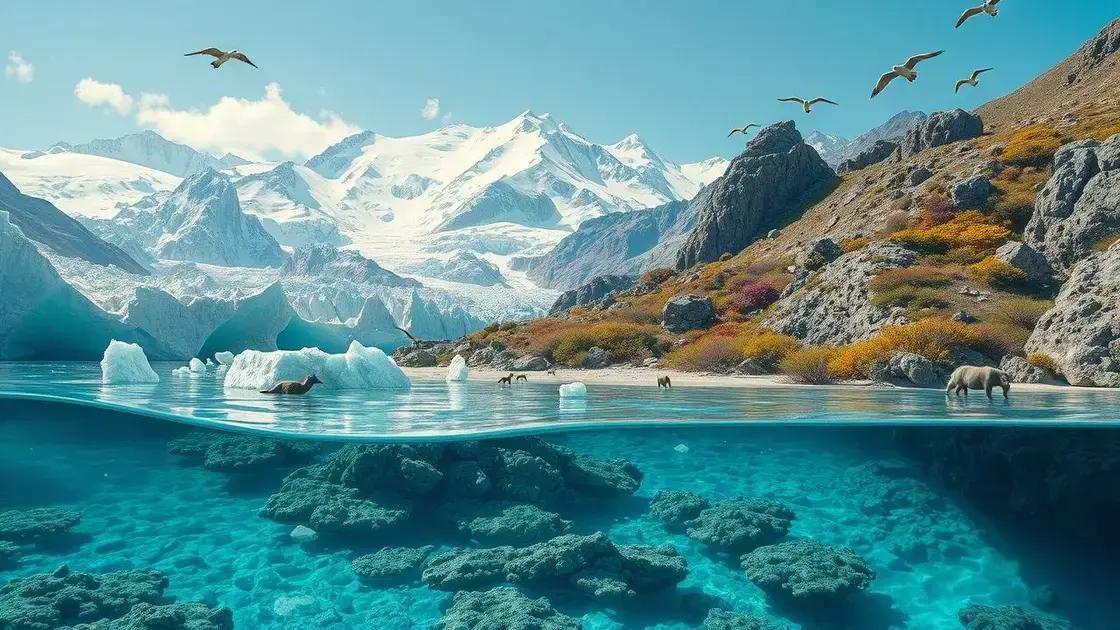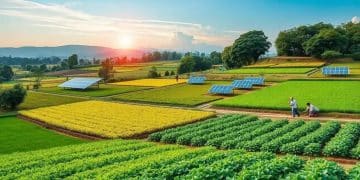Climate change impact: how it affects our daily lives

Adapting to the challenges of climate change involves building community resilience, adopting sustainable agricultural practices, fostering global collaboration, and encouraging individual actions to mitigate impacts and promote a sustainable future.
Climate change impact is a pressing issue that touches each of us daily. Have you noticed the extreme weather lately? It’s not just a coincidence. Let’s dive into how this phenomenon is reshaping our world.
Understanding the science behind climate change
Understanding the science behind climate change is essential for us to grasp its impact on our lives. This issue affects various aspects of our environment, from rising temperatures to changing weather patterns. Let’s explore the fundamental concepts of climate change.
The greenhouse effect
The greenhouse effect is a natural process that warms the Earth. When the sun’s energy reaches the Earth, some of it is reflected back to space and the rest is absorbed, warming the planet. Greenhouse gases like carbon dioxide trap some of this heat in the atmosphere. This keeps our planet warm enough to support life. However, human activities are increasing these gases.
Causes of climate change
There are several key factors contributing to the alarmingly rapid changes in our climate:
- Burning fossil fuels: This releases large amounts of carbon dioxide into the atmosphere.
- Deforestation: Cutting down trees reduces the Earth’s capacity to absorb carbon dioxide.
- Agricultural practices: Certain farming methods can release greenhouse gases.
- Industrial processes: Factories emit various greenhouse gases, worsening the situation.
These activities lead to higher concentrations of greenhouse gases, thus intensifying the greenhouse effect. As a result, we experience more extreme weather conditions and rising sea levels. It’s crucial to understand that every action counts—both big and small.
The role of climate models
Climate models play a vital role in predicting future climate scenarios. Scientists use these models to simulate the Earth’s climate system, accounting for factors like ocean currents and atmospheric conditions. This helps us to foresee potential changes and impacts, from the health of ecosystems to food security.
Ultimately, being informed about the science behind climate change allows us to make better choices to protect our planet. We can advocate for policies that reduce emissions and engage in sustainable practices to mitigate its effects.
The effects of climate change on ecosystems

The effects of climate change on ecosystems are profound and far-reaching. Various habitats are experiencing shifts that dramatically alter the lives of flora and fauna. As temperatures rise and weather patterns change, species must adapt or face extinction.
Shifts in habitat
Many ecosystems are becoming uninhabitable for species that depend on stable conditions. For instance, polar habitats are melting due to warming temperatures, forcing animals like polar bears to search for new food sources. Similarly, coral reefs are experiencing bleaching events driven by increased sea temperatures, leading to the loss of marine biodiversity.
Impact on species
Climate change is impacting species in several alarming ways:
- Migration patterns: Birds are altering their migration routes in search of suitable climates and food sources.
- Life cycles: Species are experiencing changes in reproductive timing, affecting their survival rates and population dynamics.
- Species interactions: Sorting out how different species depend on one another becomes complicated, leading to conflicts over resources.
- Invasive species: Warmer climates allow non-native species to thrive, which can outcompete local species, disrupting the ecosystem balance.
These impacts are not isolated; they ripple through ecosystems, affecting food webs and ecosystem services. For example, as some insects flourish, their natural predators may struggle to adapt, leading to population imbalances.
Changes in biodiversity
Biodiversity is a crucial component of healthy ecosystems. Unfortunately, climate change puts immense pressure on this biodiversity, leading to losses in species and genetic diversity. Terrestrial, freshwater, and marine ecosystems all face threats from shifting climates. This decrease in diversity weakens ecosystems and hampers their ability to provide vital services, such as clean water, pollination, and carbon storage.
Ultimately, understanding the effects of climate change on ecosystems is essential for conservation efforts. By recognizing these changes and working to mitigate further impacts, we can help preserve our planet’s precious biodiversity.
How climate change influences weather patterns
Climate change has a significant impact on how weather patterns behave around the world. With the rise in global temperatures, we are witnessing changes that can be both dramatic and subtle. These changes can affect everything from precipitation levels to storm intensity.
Increased rainfall and flooding
One major effect of climate change is the alteration of rainfall patterns. Some regions experience increased rainfall, leading to severe flooding. This excessive water can damage homes, crops, and infrastructure. The frequency of weather events such as heavy rain and thunderstorms has also risen.
Drought conditions
Conversely, other areas face longer and more intense droughts. The drying of these regions can lead to:
- Water shortages: Limited water supply for drinking and agriculture.
- Crop failure: Reduced agricultural yield affects food supply.
- Wildfires: Dry vegetation increases the risk of wildfires, threatening ecosystems and human lives.
- Economic impact: Drought can harm local economies dependent on agriculture and water resources.
Both flooding and drought highlight the extreme variability in weather that climate change can cause. These effects can disturb seasonal cycles, making it harder for farmers to plan their planting and harvesting times.
Changing hurricane patterns
Another aspect of climate change is its influence on tropical storms. Warmer ocean waters can energize hurricanes, leading to more intense storms with higher winds and increased rainfall. This raises the potential for catastrophic damage in coastal areas. Communities often find themselves unprepared for the aftermath of such powerful storms.
Understanding how climate change influences weather patterns helps us prepare for the future. By acknowledging these changes, we can adapt our infrastructure and policies to protect communities and ecosystems alike.
Adapting to the challenges of climate change

Adapting to the challenges of climate change is crucial for communities and ecosystems worldwide. As we face more extreme weather and environmental shifts, finding ways to adjust our behaviors and systems becomes essential.
Community resilience
Building community resilience is one of the key strategies. Local governments and organizations play a vital role in helping communities prepare for climate impacts. They can create plans that involve:
- Emergency preparedness: Establishing systems to respond to natural disasters like floods and hurricanes.
- Public education: Informing residents about climate risks and sustainable practices.
- Infrastructure improvements: Investing in stronger buildings and stormwater systems to manage extreme weather.
- Support for vulnerable populations: Ensuring those most at risk have resources and assistance.
These efforts help communities to not only survive but thrive in the face of climate change.
Innovative agricultural practices
Adaptation also extends to agriculture, where farmers must adjust to changing weather patterns. Techniques like sustainable farming, crop rotation, and water-efficient irrigation systems can enhance resilience. Additionally, planting drought-resistant crop varieties ensures that food production remains stable even with environmental changes.
Organizations are now focusing on promoting practices that reduce emissions while adapting to the inevitable impacts of climate change. These include integrating technology to improve yields and reduce resource use systematically.
Collaborative actions
Another important part of adapting is global collaboration. Countries around the world must work together to share knowledge and develop best practices. Engaging in international agreements, like the Paris Agreement, lays the foundation for global cooperation on climate issues. Sharing resources can help less-developed nations implement adaptation strategies effectively, empowering their communities.
In individual actions, everyone can contribute to adaptation. Simple choices like reducing water use, conserving energy, and supporting local products help build a more sustainable future. By recognizing our role in this challenge, we can collectively make a difference.
In conclusion, adapting to the challenges of climate change is essential for ensuring a sustainable future. Communities, farmers, and countries must work together to build resilience and find solutions that fit their specific needs. By embracing innovative practices and fostering collaboration, we can mitigate the impacts of climate change and create a better environment for everyone. Remember, every small action counts, and together we can make a significant difference!
FAQ – Frequently Asked Questions About Adapting to Climate Change
What is community resilience?
Community resilience refers to the ability of a community to prepare for, respond to, and recover from the impacts of climate change and extreme weather events.
How can farmers adapt to climate change?
Farmers can adapt by implementing sustainable farming practices, such as crop rotation, using drought-resistant crops, and optimizing water use.
Why is global collaboration important for climate change adaptation?
Global collaboration helps share resources, knowledge, and strategies that empower countries to effectively address the impacts of climate change together.
What actions can individuals take to help adapt to climate change?
Individuals can take simple actions like conserving water, reducing energy use, and supporting local products to contribute to climate change adaptation efforts.






